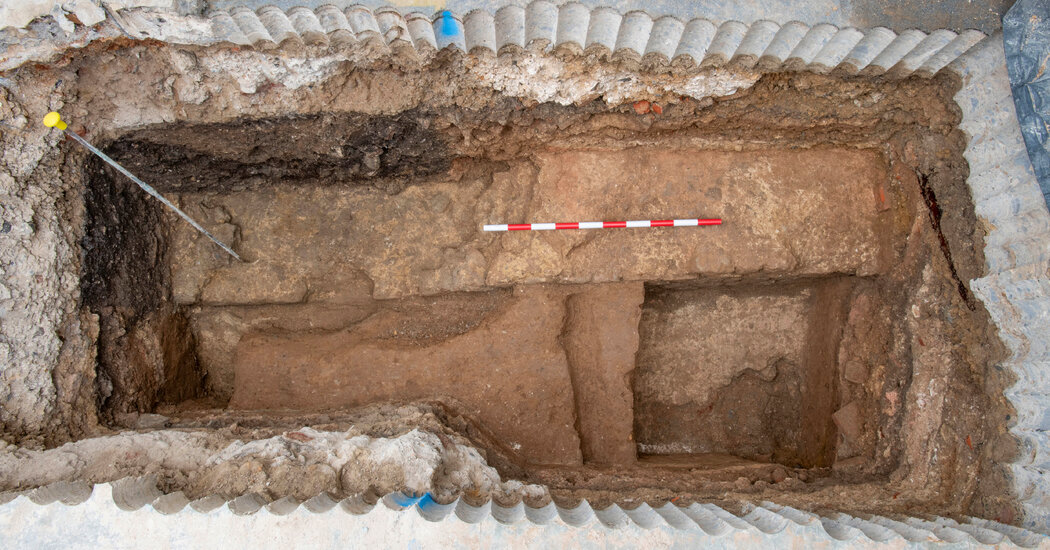Archaeologists have unearthed the foundations of London’s first public building.
Excavating under the basement of a commercial building in the city’s financial district, they encountered what they believe are the roughly 2,000-year-old remains of a basilica from Roman London.
The basilica was part of London’s Roman forum, or public square, and was “effectively the first town hall,” said Sophie Jackson, a director at the Museum of London Archaeology.
The archaeologists first found the remnants over the summer and completed their investigation a few weeks ago, Ms. Jackson said. They began work after planning permission was granted to demolish a commercial building at the site and replace it with a 32-story mixed-use office tower.
They unearthed “massive foundations and walls made of flint, ragstone and Roman tile,” the museum said in a statement announcing the discovery on Thursday. In some areas, these remnants were more than 33 feet long, three feet wide and 13 feet deep, the statement said.
Their size and scope indicates that the basilica, which must have been the city’s biggest structure at the time, was three stories high and built atop a hill, Ms. Jackson said in a phone interview on Thursday. She added that it was probably a place where administrative matters were resolved and money may have been stored.
Archaeologists also believe that the site that was excavated was a designated area inside the basilica called a tribunal, where magistrates sat on a raised platform and made judgments on court cases and important decisions about the government, Ms. Jackson said.
“This was a clear symbol of Roman power and authority,” the museum said.
Archaeologists had known of the existence of the basilica, but they did not know how much of it had survived underneath the streets of London, nor did they expect such a high level of preservation.
The remains were found in the center of a bustling metropolis, in an area of London that essentially has the same function now as it did thousands of years ago under Roman rule. The Museum of London Archaeology said the basilica was “once the beating heart of Roman London.”
“Trying to understand Roman London is a puzzle,” Ms. Jackson said, and “most of the pieces have been lost.”
The Romans conquered Britain in 43 A.D. and established London, then known as Londinium, about five years later. The city at that point was an industrial port with a quickly growing transportation network. Thirteen years into the founding of Londinium, British tribes led a rebellion against the Romans and destroyed most of the city.
Roughly 15 years later, in the late 70s or 80s A.D., the Romans rebuilt the city, including the recently unearthed basilica. The Romans also built a bath house and an amphitheater in the same area around the same time.
Ron Hertshten, the chief executive of Hertshten Properties, the company that is redeveloping the site, said that “the discovery of the remains under our building has caused us to significantly revise our plans.” The company, he said, planned to incorporate the remains into a public display that would be open to the public.
Archaeologists hope that the revelation of the remains will lead to more discoveries about Roman London. After the existing building is demolished, they will be able to do a full excavation, Ms. Jackson said. “We’ll find out so much about the origin of London and the lives of the first Londoners,” she said.
The remains of the basilica are hardly the first significant archaeological discovery in London. In 2022, archaeologists dug up two extremely well-preserved Roman mosaics. In 2017, when Bloomberg completed a large office building in the City of London, it incorporated the 2,000-year-old Temple of Mithras, another relic of London’s days under Roman rule that was first discovered in the 1950s, into its design.
It was not even the first time that Roman ruins had been found on the same street.
“A Roman mystery has sent London citizens scurrying to the scene of recent excavations,” The New York Times reported in February 1926, when remnants of the forum were discovered during the construction of a Barclays Bank building on Gracechurch Street, about 350 feet from the site of the recent basilica discovery.
“Only two or three pieces of it will be preserved,” The Times reported. “The remainder will once more be lost sight of, to offer no doubt a puzzle to future generations rearing habitations undreamed of by this one.”


